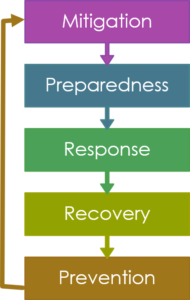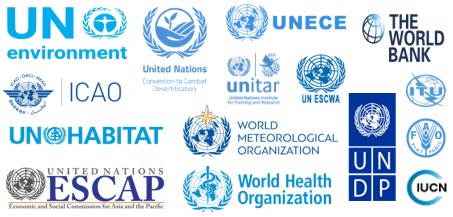UN Coalition to Combat Sand and Dust Storms

Sand and Dust Storms
Sand and dust storms present a formidable and wide-spread challenge to achieving sustainable development in its economic, social and environmental dimensions. They have become a serious global concern in recent decades due to their significant impacts on the environment, health, agriculture, livelihoods, and socio-economic well-being. Sand and dust storms are an essential element of the Earth’s natural bio chemical cycles but are also caused in part by human-induced drivers including climate change, unsustainable land management, and water use, and in turn sand and dust storms contribute to climate change and air pollution. Sand and dust storms’ impacts are felt in all regions of the world, both in developed and developing countries, and pose severe challenges to achieving the Sustainable Development Goals, including SDGs 2, 3, 6, 8, 11, 13, and 15 in affected developing countries (see General Assembly resolution 70/1).
Key facts
- Approx. 2 million tonnes of sand and dust enter the atmosphere annually
- SDS mostly occur in dry and desert regions but can be carried long distances to impact regions much further away
- Dust particles, circulated by SDS, provide nutrients to marine ecosystems, but can also contribute to coral mortality and hurricane formation
- SDS can cause respiratory diseases, heart disorders, and eye and skin irritation and can also spread other diseases, such as meningitis
- Aviation and ground transportation can be disrupted by SDS
- Agricultural practices and productivity can be impacted by SDS, which can also contribute to desertification processes
- Sustainable water and land management practices can decrease the impacts of SDS
The UN Sand and Dust Storm (SDS) Coalition
The 24th Senior Officials Meeting of the EMG in 2018 led to the formation of a Coalition to Combat Sand and Dust Storms. This was in response to UN General Assembly Resolution 72/225 (2018) and the preceding UN Environment Assembly Resolution 2/21 (2016). The Coalition is made up of 15 nominated UN agency Focal Points.
Meetings of the Coalition
The first meeting was held on February 14, 2019, by teleconference.
The second meeting of the SDS Coalition was held in the margins of the UNCCD COP14 on 5-6 September 2019 in New Delhi, India.
The Meeting was comprised of two segments:
1. An informal technical segment (5 September)
- Agenda
- Background Note
- SDS Coalition Terms of Reference
- SDS App Terms of Reference
- Draft Action Plan
- Draft Strategy
2. A formal segment to launch the Coalition during the SDS day (see Notification and Concept Note) on 6 September 2019
The report of the SDS Coalition informal meeting and launch will be published shortly.
3. Presentations made during the SDS Day
- Recent SDS Activities- Nick Middleton, UNEP
- SDS impacts- Hesham El-Askry, Chapman University
- A global SDS source mapping- Marijana Kapovic-Solomun, UNCCD SPI
- Sand dust mapping approach based on data fusion of satellite image and UAV observations: A case study in Mongolia- Jungrak Kim, University of Seoul
- Launch of the SDS Coalition
- SDS vulnerability assessment and mapping- Sanjay Srivastava, UNESCAP
- SDS source mitigation- Enrico Bonaiuti, ICARDA/WOCAT
- Human Security Trust Fund on Aral Sea- Bahodir Kuziev, Uzbekistan
- Central Asia SDS Initiative- Jamal Annagylyjova, UNCCD
- Transboundary cooperation- Abeer Suwaid Alabri, Kuwait, and Rawea Mahmood, Iraq
- Support to SDS monitoring and forecast for the Sahelian countries- Jose Camacho, WMO
- Presentation of the SDS Compendium- Utchang Kang, UNCCD
The Technical Workshop on SDS Risk Assessment Methodology was held in the margins of the fifth meeting of the WMO SDS Warning Advisory System Steering Committee (SDS WAS SC) on November 14, 2019 in Hangzhou, China.
The meeting discussed the tasks of Working Group 2 of the coalition
- Agenda– SDS meeting agenda can be found in the afternoon of Day 2 in this broader agenda for the SDS WAS SC
The Third Meeting of the Coalition will be held on the 2nd of July 2020 as an online conference.
The main objectives of the meeting are to consider and adopt the Coalition’s framework documents an transfer the coalition’s chair and host from UNEP to FAO.
The Coalition Working Groups
As outlined in the ToR, part of the modalities of the Coalition four cross-cutting work areas are addressed: facilitating information exchange; capacity building and training; mobilising resources and fundraising, and; advocacy and awareness raising. These four work areas are being addressed by five cross-cutting Working Groups, each lead and co-lead by a member of the Coalition with the most relevant experience and knowledge.
The Working Groups were identified using the Disaster Risk Management Cycle (pictured below) and designed to focus on specific stages of the cycle. In this way they are able to address specific phases of the SDS life cycle.

-
WG#1- Adaptation and mitigation
Awaiting activation by FAO -
WG#2- Forecasting and early warning
Being activated by WMO -
WG#3- Health and safety
Awaiting activation by WHO -
WG#4- Policy and governance
Awaiting activation by UNEP and UNCCD -
WG#5- Mediation and regional collaboration
Being activated by UN ESCAP as part of their DRR platform
If you are interested in participating, please contact [email protected].
Members of the SDS Coalition
